Abstract
Sets of overlapping synthetic peptides containing predicted T-cell epitope motifs were designed from the murine monoclonal antibody-defined map of linear B-cell epitope domains within each of the structural proteins of rubella virus (RV). The peptides represented well-defined subsequences of two capsid domains (C1 to C29 and C64 to C97), of a domain of glycoprotein E1 containing neutralizing determinants (E1(202) to E1(283), and of a domain of glycoprotein E2 (E2(31) to E2(105). With the exception of peptides representing C64 to C97, each set of peptides stimulated varied but individually specific lymphoproliferative responses in peripheral blood mononuclear cells from 25 to 50% of a representatively large number of normal, RV-immune human donors with diverse human leukocyte antigen (HLA) backgrounds. Responses were mediated by CD4+ T cells in association with HLA class II antigens, though lymphoproliferative responses to a given peptide were usually not HLA-DR allele specific. Correlation analysis of responses to overlapping peptides suggests that there is an immunodominant T-proliferative epitope within C14 to C29 recognized by approximately 50% of the donor population. However, limiting-dilution analysis indicated much variability between individuals in lymphocyte recognition of this T-cell determinant, even within similar HLA-DR contexts. Thus, the fine specificity of relatively immunodominant T-cell epitopes may vary from individual to individual. Synthetic peptides with predicted T-cell motifs have proved to be useful probes of the molecular determinants of cellular immunity to RV and should expand the rational basis for the design of synthetic RV vaccines.
Full text
PDF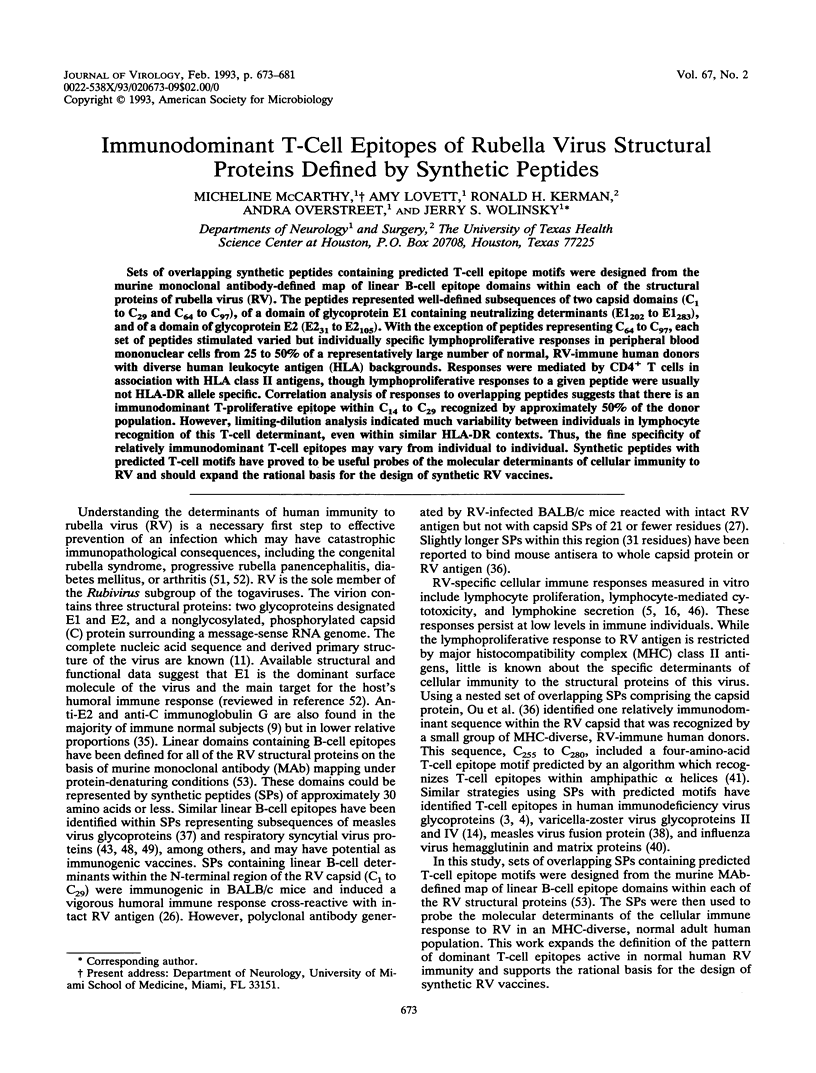
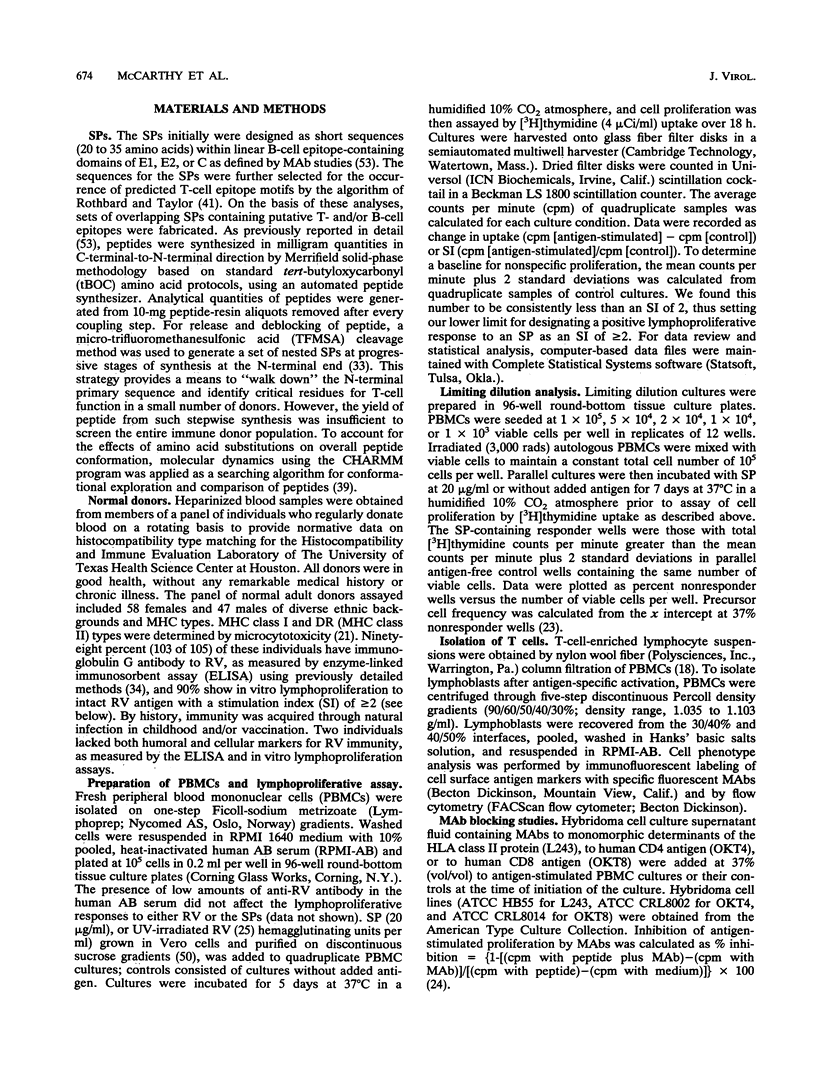
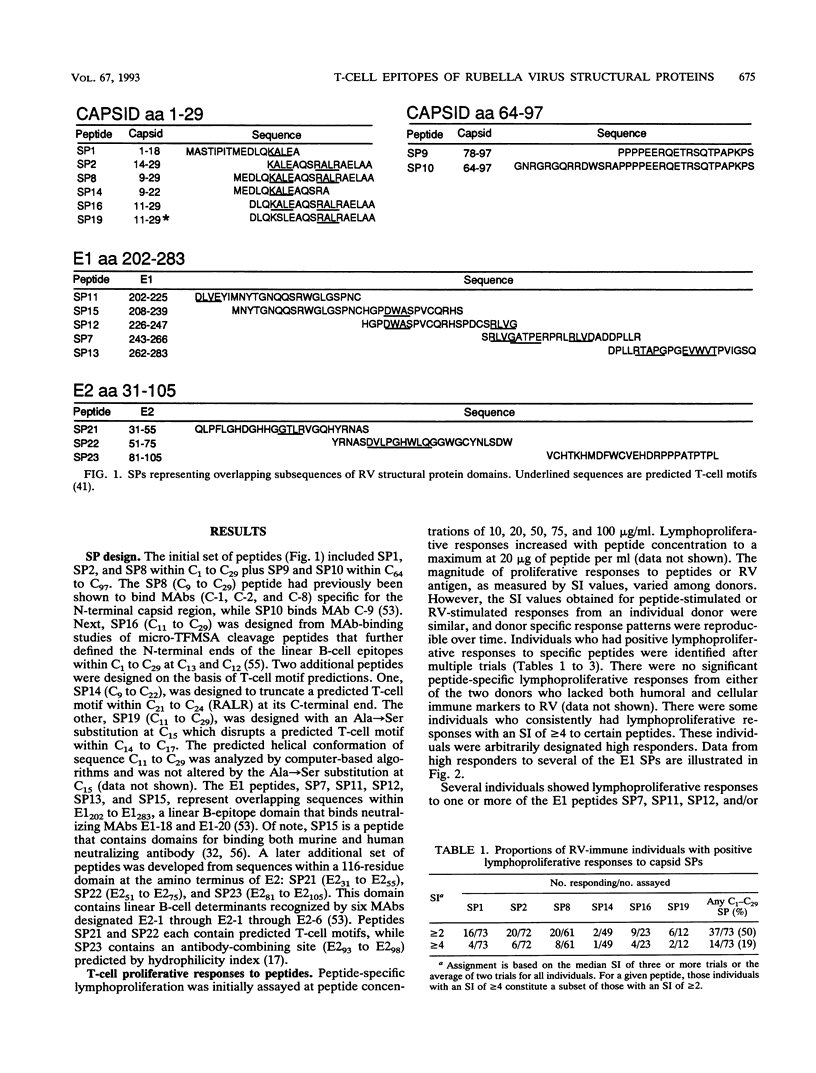
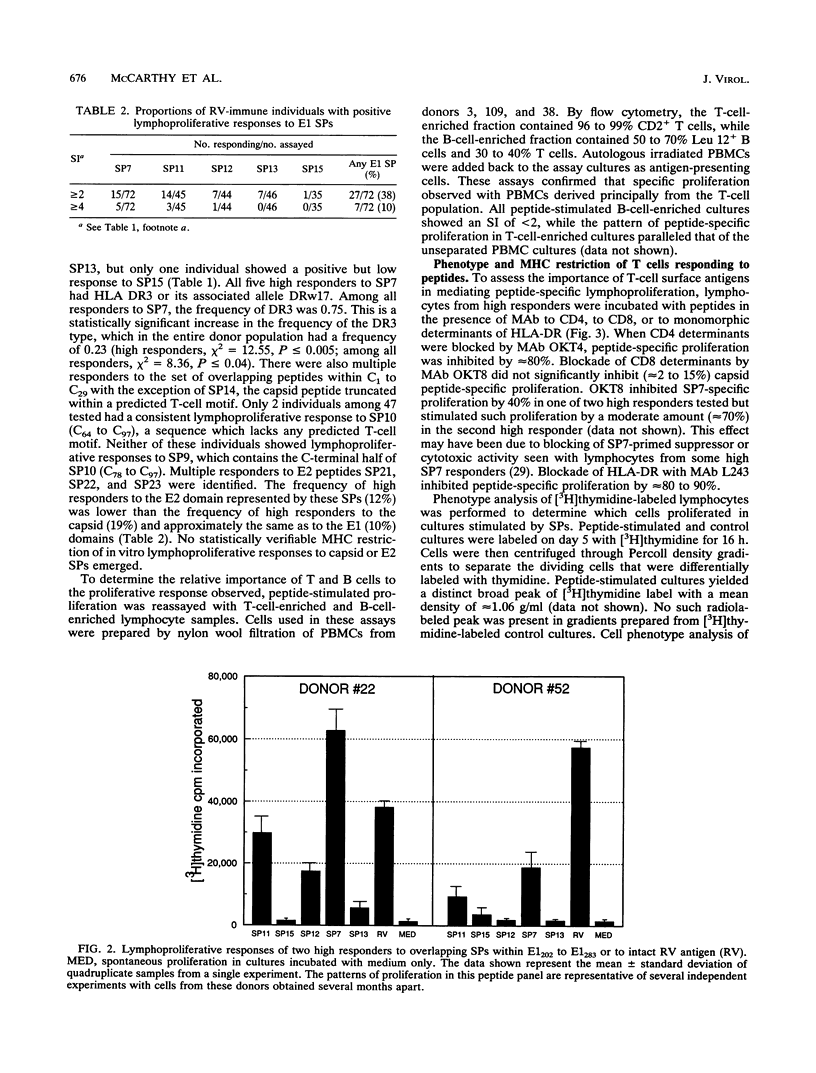
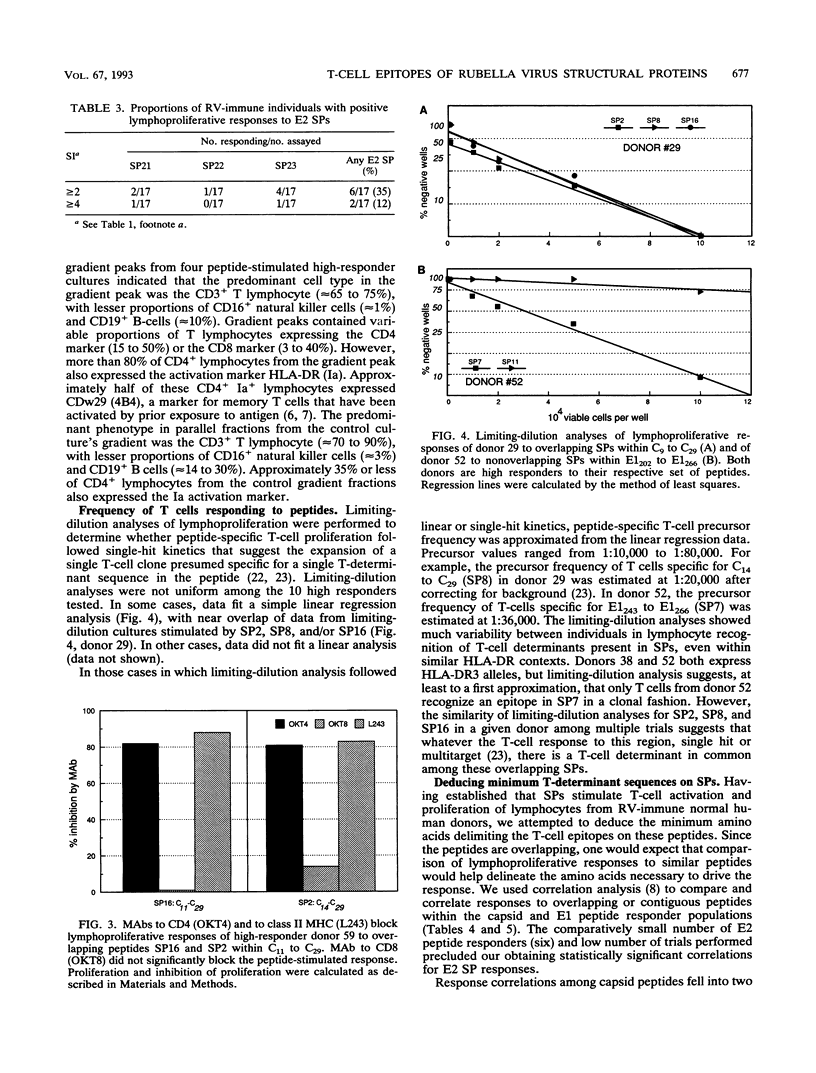
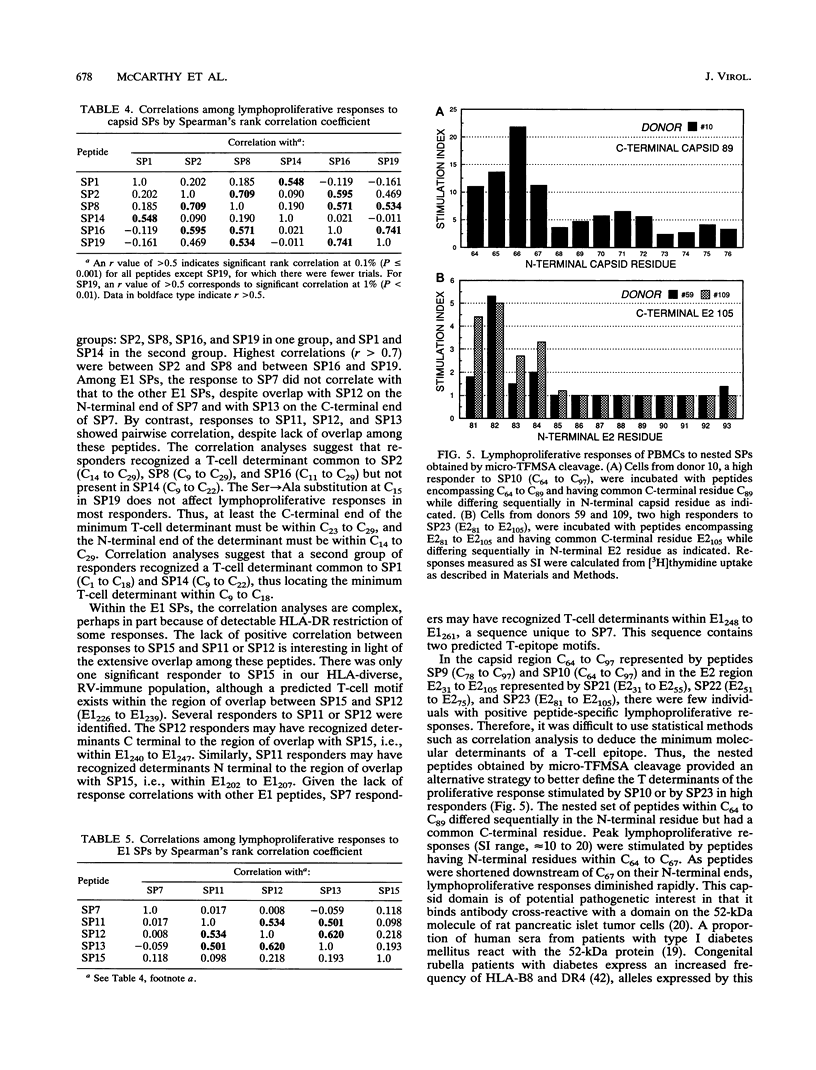
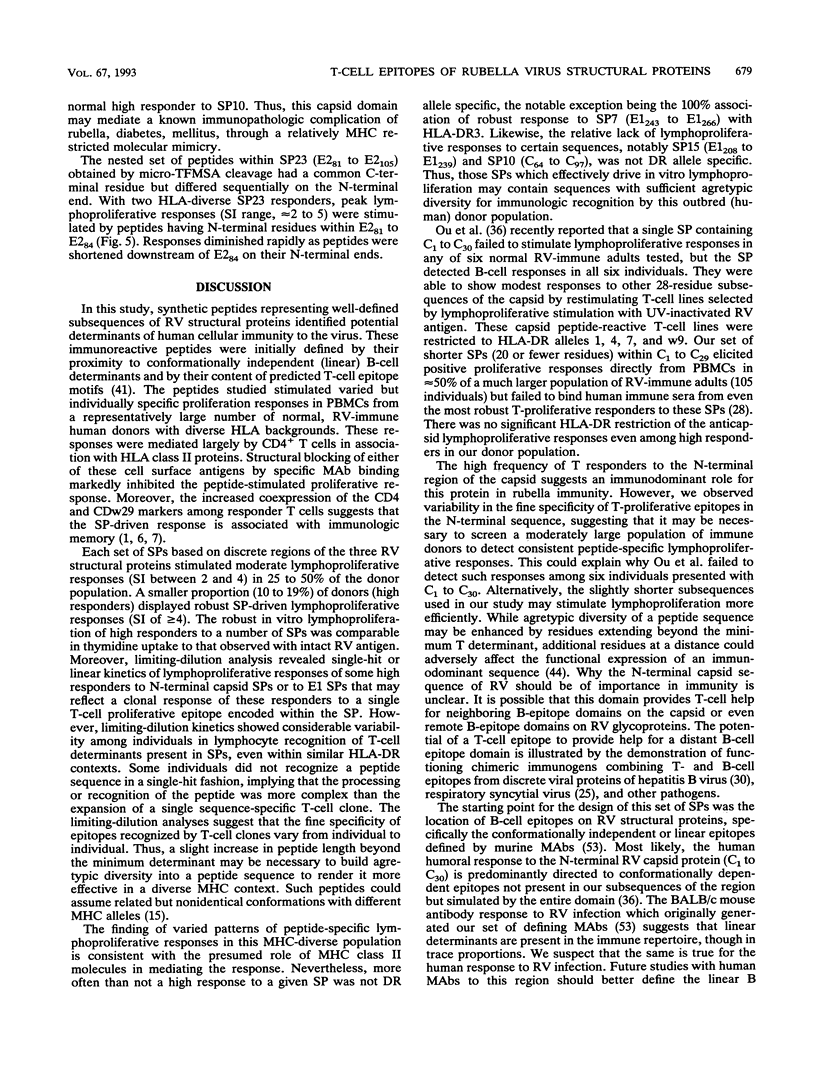
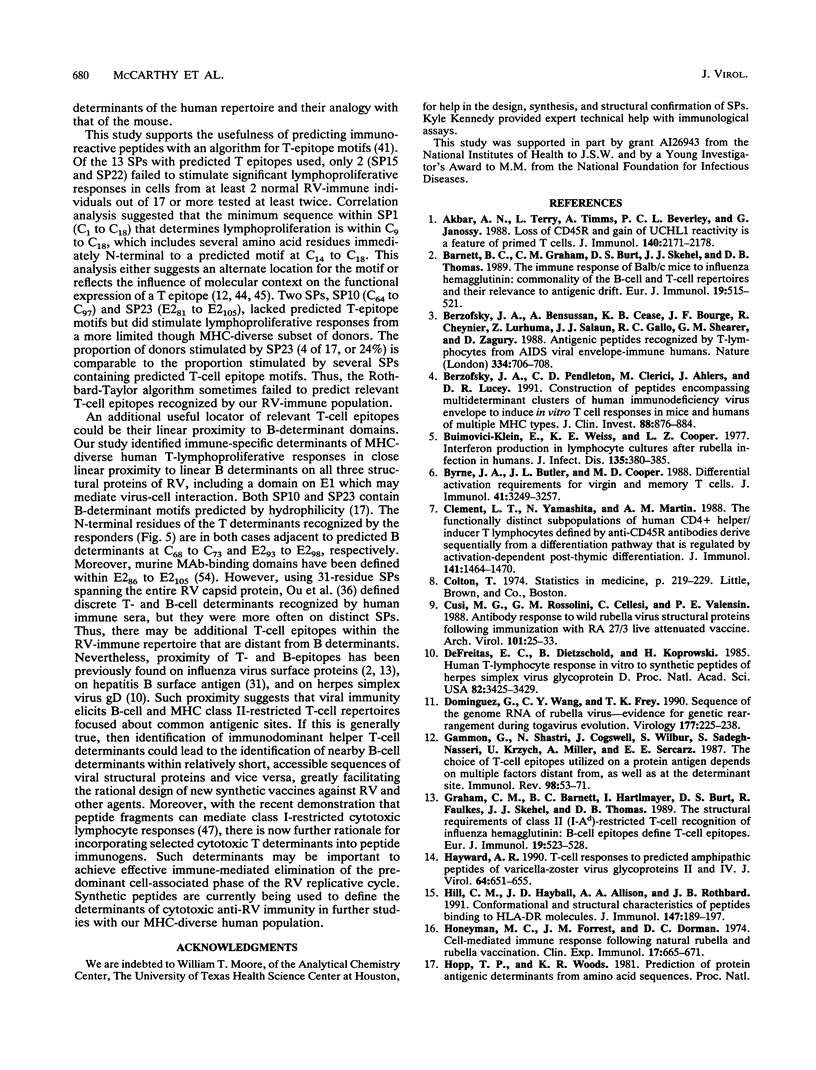
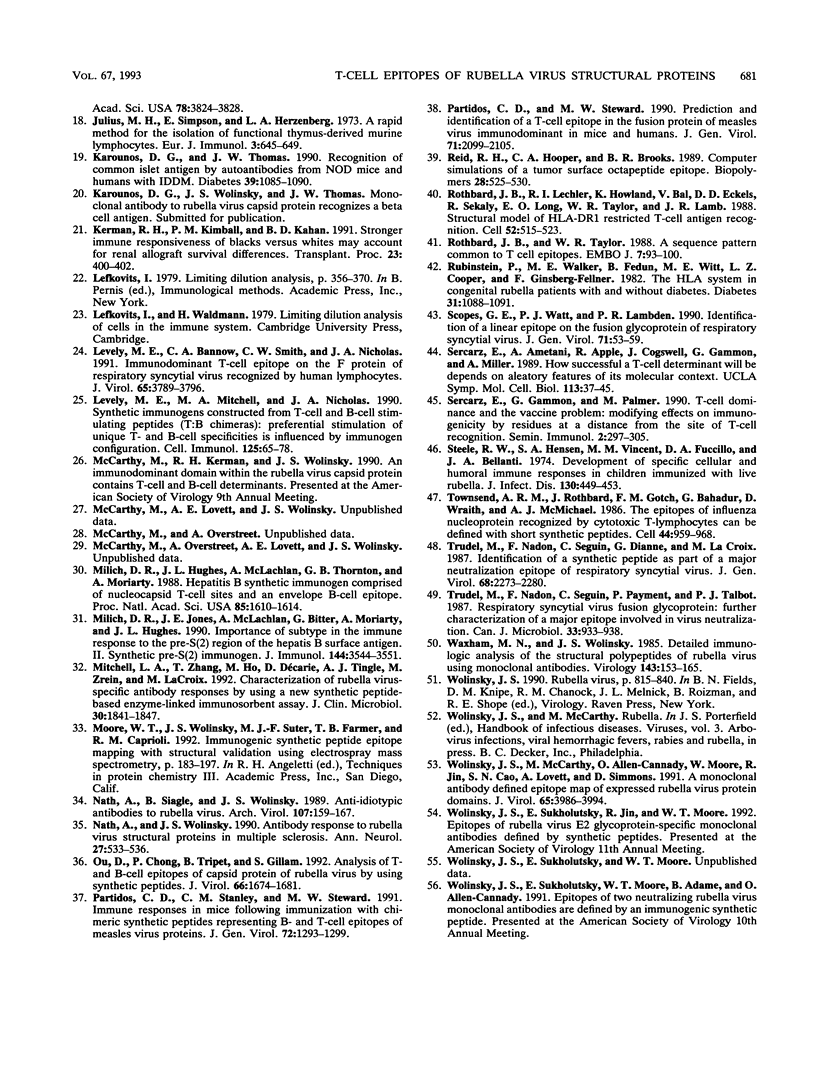
Selected References
These references are in PubMed. This may not be the complete list of references from this article.
- Akbar A. N., Terry L., Timms A., Beverley P. C., Janossy G. Loss of CD45R and gain of UCHL1 reactivity is a feature of primed T cells. J Immunol. 1988 Apr 1;140(7):2171–2178. [PubMed] [Google Scholar]
- Barnett B. C., Graham C. M., Burt D. S., Skehel J. J., Thomas D. B. The immune response of BALB/c mice to influenza hemagglutinin: commonality of the B cell and T cell repertoires and their relevance to antigenic drift. Eur J Immunol. 1989 Mar;19(3):515–521. doi: 10.1002/eji.1830190316. [DOI] [PubMed] [Google Scholar]
- Berzofsky J. A., Bensussan A., Cease K. B., Bourge J. F., Cheynier R., Lurhuma Z., Salaün J. J., Gallo R. C., Shearer G. M., Zagury D. Antigenic peptides recognized by T lymphocytes from AIDS viral envelope-immune humans. Nature. 1988 Aug 25;334(6184):706–708. doi: 10.1038/334706a0. [DOI] [PubMed] [Google Scholar]
- Berzofsky J. A., Pendleton C. D., Clerici M., Ahlers J., Lucey D. R., Putney S. D., Shearer G. M. Construction of peptides encompassing multideterminant clusters of human immunodeficiency virus envelope to induce in vitro T cell responses in mice and humans of multiple MHC types. J Clin Invest. 1991 Sep;88(3):876–884. doi: 10.1172/JCI115389. [DOI] [PMC free article] [PubMed] [Google Scholar]
- Buimovici-Klein E., Weiss K. E., Cooper L. Z. Interferon production in lymphocyte cultures after rubella infection in humans. J Infect Dis. 1977 Mar;135(3):380–385. doi: 10.1093/infdis/135.3.380. [DOI] [PubMed] [Google Scholar]
- Byrne J. A., Butler J. L., Cooper M. D. Differential activation requirements for virgin and memory T cells. J Immunol. 1988 Nov 15;141(10):3249–3257. [PubMed] [Google Scholar]
- Clement L. T., Yamashita N., Martin A. M. The functionally distinct subpopulations of human CD4+ helper/inducer T lymphocytes defined by anti-CD45R antibodies derive sequentially from a differentiation pathway that is regulated by activation-dependent post-thymic differentiation. J Immunol. 1988 Sep 1;141(5):1464–1470. [PubMed] [Google Scholar]
- Cusi M. G., Rossolini G. M., Cellesi C., Valensin P. E. Antibody response to wild rubella virus structural proteins following immunization with RA 27/3 live attenuated vaccine. Arch Virol. 1988;101(1-2):25–33. doi: 10.1007/BF01314649. [DOI] [PubMed] [Google Scholar]
- DeFreitas E. C., Dietzschold B., Koprowski H. Human T-lymphocyte response in vitro to synthetic peptides of herpes simplex virus glycoprotein D. Proc Natl Acad Sci U S A. 1985 May;82(10):3425–3429. doi: 10.1073/pnas.82.10.3425. [DOI] [PMC free article] [PubMed] [Google Scholar]
- Dominguez G., Wang C. Y., Frey T. K. Sequence of the genome RNA of rubella virus: evidence for genetic rearrangement during togavirus evolution. Virology. 1990 Jul;177(1):225–238. doi: 10.1016/0042-6822(90)90476-8. [DOI] [PMC free article] [PubMed] [Google Scholar]
- Graham C. M., Barnett B. C., Hartlmayr I., Burt D. S., Faulkes R., Skehel J. J., Thomas D. B. The structural requirements for class II (I-Ad)-restricted T cell recognition of influenza hemagglutinin: B cell epitopes define T cell epitopes. Eur J Immunol. 1989 Mar;19(3):523–528. doi: 10.1002/eji.1830190317. [DOI] [PubMed] [Google Scholar]
- Hayward A. R. T-cell responses to predicted amphipathic peptides of varicella-zoster virus glycoproteins II and IV. J Virol. 1990 Feb;64(2):651–655. doi: 10.1128/jvi.64.2.651-655.1990. [DOI] [PMC free article] [PubMed] [Google Scholar]
- Hill C. M., Hayball J. D., Allison A. A., Rothbard J. B. Conformational and structural characteristics of peptides binding to HLA-DR molecules. J Immunol. 1991 Jul 1;147(1):189–197. [PubMed] [Google Scholar]
- Honeyman M. C., Forrest J. M., Dorman D. C. Cell-mediated immune response following natural rubella and rubella vaccination. Clin Exp Immunol. 1974 Aug;17(4):665–671. [PMC free article] [PubMed] [Google Scholar]
- Hopp T. P., Woods K. R. Prediction of protein antigenic determinants from amino acid sequences. Proc Natl Acad Sci U S A. 1981 Jun;78(6):3824–3828. doi: 10.1073/pnas.78.6.3824. [DOI] [PMC free article] [PubMed] [Google Scholar]
- Julius M. H., Simpson E., Herzenberg L. A. A rapid method for the isolation of functional thymus-derived murine lymphocytes. Eur J Immunol. 1973 Oct;3(10):645–649. doi: 10.1002/eji.1830031011. [DOI] [PubMed] [Google Scholar]
- Karounos D. G., Thomas J. W. Recognition of common islet antigen by autoantibodies from NOD mice and humans with IDDM. Diabetes. 1990 Sep;39(9):1085–1090. doi: 10.2337/diab.39.9.1085. [DOI] [PubMed] [Google Scholar]
- Kerman R. H., Kimball P. M., Van Buren C. T., Lewis R. M., DeVera V., Baghdahsarian V., Heydari A., Kahan B. D. Improved renal allograft survival for AHG and DTE/AHG crossmatch-negative recipients. Transplant Proc. 1991 Feb;23(1 Pt 1):400–402. [PubMed] [Google Scholar]
- Levely M. E., Bannow C. A., Smith C. W., Nicholas J. A. Immunodominant T-cell epitope on the F protein of respiratory syncytial virus recognized by human lymphocytes. J Virol. 1991 Jul;65(7):3789–3796. doi: 10.1128/jvi.65.7.3789-3796.1991. [DOI] [PMC free article] [PubMed] [Google Scholar]
- Levely M. E., Mitchell M. A., Nicholas J. A. Synthetic immunogens constructed from T-cell and B-cell stimulating peptides (T:B chimeras): preferential stimulation of unique T- and B-cell specificities is influenced by immunogen configuration. Cell Immunol. 1990 Jan;125(1):65–78. doi: 10.1016/0008-8749(90)90063-w. [DOI] [PubMed] [Google Scholar]
- Milich D. R., Hughes J. L., McLachlan A., Thornton G. B., Moriarty A. Hepatitis B synthetic immunogen comprised of nucleocapsid T-cell sites and an envelope B-cell epitope. Proc Natl Acad Sci U S A. 1988 Mar;85(5):1610–1614. doi: 10.1073/pnas.85.5.1610. [DOI] [PMC free article] [PubMed] [Google Scholar]
- Milich D. R., Jones J. E., McLachlan A., Bitter G., Moriarty A., Hughes J. L. Importance of subtype in the immune response to the pre-S(2) region of the hepatitis B surface antigen. II. Synthetic Pre-S(2) immunogen. J Immunol. 1990 May 1;144(9):3544–3551. [PubMed] [Google Scholar]
- Mitchell L. A., Zhang T., Ho M., Décarie D., Tingle A. J., Zrein M., Lacroix M. Characterization of rubella virus-specific antibody responses by using a new synthetic peptide-based enzyme-linked immunosorbent assay. J Clin Microbiol. 1992 Jul;30(7):1841–1847. doi: 10.1128/jcm.30.7.1841-1847.1992. [DOI] [PMC free article] [PubMed] [Google Scholar]
- Nath A., Slagle B., Wolinsky J. S. Anti-idiotypic antibodies to rubella virus. Arch Virol. 1989;107(1-2):159–167. doi: 10.1007/BF01313888. [DOI] [PubMed] [Google Scholar]
- Nath A., Wolinsky J. S. Antibody response to rubella virus structural proteins in multiple sclerosis. Ann Neurol. 1990 May;27(5):533–536. doi: 10.1002/ana.410270513. [DOI] [PubMed] [Google Scholar]
- Ou D., Chong P., Tripet B., Gillam S. Analysis of T- and B-cell epitopes of capsid protein of rubella virus by using synthetic peptides. J Virol. 1992 Mar;66(3):1674–1681. doi: 10.1128/jvi.66.3.1674-1681.1992. [DOI] [PMC free article] [PubMed] [Google Scholar]
- Partidos C. D., Stanley C. M., Steward M. W. Immune responses in mice following immunization with chimeric synthetic peptides representing B and T cell epitopes of measles virus proteins. J Gen Virol. 1991 Jun;72(Pt 6):1293–1299. doi: 10.1099/0022-1317-72-6-1293. [DOI] [PubMed] [Google Scholar]
- Partidos C. D., Steward M. W. Prediction and identification of a T cell epitope in the fusion protein of measles virus immunodominant in mice and humans. J Gen Virol. 1990 Sep;71(Pt 9):2099–2105. doi: 10.1099/0022-1317-71-9-2099. [DOI] [PubMed] [Google Scholar]
- Reid R. H., Hooper C. A., Brooks B. R. Computer simulations of a tumor surface octapeptide epitope. Biopolymers. 1989 Jan;28(1):525–530. doi: 10.1002/bip.360280146. [DOI] [PubMed] [Google Scholar]
- Rothbard J. B., Lechler R. I., Howland K., Bal V., Eckels D. D., Sekaly R., Long E. O., Taylor W. R., Lamb J. R. Structural model of HLA-DR1 restricted T cell antigen recognition. Cell. 1988 Feb 26;52(4):515–523. doi: 10.1016/0092-8674(88)90464-3. [DOI] [PubMed] [Google Scholar]
- Rothbard J. B., Taylor W. R. A sequence pattern common to T cell epitopes. EMBO J. 1988 Jan;7(1):93–100. doi: 10.1002/j.1460-2075.1988.tb02787.x. [DOI] [PMC free article] [PubMed] [Google Scholar]
- Rubinstein P., Walker M. E., Fedun B., Witt M. E., Cooper L. Z., Ginsberg-Fellner F. The HLA system in congenital rubella patients with and without diabetes. Diabetes. 1982 Dec;31(12):1088–1091. doi: 10.2337/diacare.31.12.1088. [DOI] [PubMed] [Google Scholar]
- Scopes G. E., Watt P. J., Lambden P. R. Identification of a linear epitope on the fusion glycoprotein of respiratory syncytial virus. J Gen Virol. 1990 Jan;71(Pt 1):53–59. doi: 10.1099/0022-1317-71-1-53. [DOI] [PubMed] [Google Scholar]
- Sercarz E., Gammon G., Palmer M. T cell dominance and the vaccine problem: modifying effects on immunogenicity by residues at a distance from the site of T cell recognition. Semin Immunol. 1990 Sep;2(5):297–305. [PubMed] [Google Scholar]
- Steele R. W., Hensen S. A., Vincent M. M., Fuccillo D. A., Bellanti J. A. Development of specific cellular and humoral immune responses in children immunized with live rubella virus vaccine. J Infect Dis. 1974 Nov;130(5):449–453. doi: 10.1093/infdis/130.5.449. [DOI] [PubMed] [Google Scholar]
- Townsend A. R., Rothbard J., Gotch F. M., Bahadur G., Wraith D., McMichael A. J. The epitopes of influenza nucleoprotein recognized by cytotoxic T lymphocytes can be defined with short synthetic peptides. Cell. 1986 Mar 28;44(6):959–968. doi: 10.1016/0092-8674(86)90019-x. [DOI] [PubMed] [Google Scholar]
- Trudel M., Nadon F., Seguin C., Dionne G., Lacroix M. Identification of a synthetic peptide as part of a major neutralization epitope of respiratory syncytial virus. J Gen Virol. 1987 Sep;68(Pt 9):2273–2280. doi: 10.1099/0022-1317-68-9-2273. [DOI] [PubMed] [Google Scholar]
- Trudel M., Nadon F., Séguin C., Payment P., Talbot P. J. Respiratory syncytial virus fusion glycoprotein: further characterization of a major epitope involved in virus neutralization. Can J Microbiol. 1987 Oct;33(10):933–938. doi: 10.1139/m87-164. [DOI] [PubMed] [Google Scholar]
- Waxham M. N., Wolinsky J. S. Detailed immunologic analysis of the structural polypeptides of rubella virus using monoclonal antibodies. Virology. 1985 May;143(1):153–165. doi: 10.1016/0042-6822(85)90104-7. [DOI] [PubMed] [Google Scholar]
- Wolinsky J. S., McCarthy M., Allen-Cannady O., Moore W. T., Jin R., Cao S. N., Lovett A., Simmons D. Monoclonal antibody-defined epitope map of expressed rubella virus protein domains. J Virol. 1991 Aug;65(8):3986–3994. doi: 10.1128/jvi.65.8.3986-3994.1991. [DOI] [PMC free article] [PubMed] [Google Scholar]


